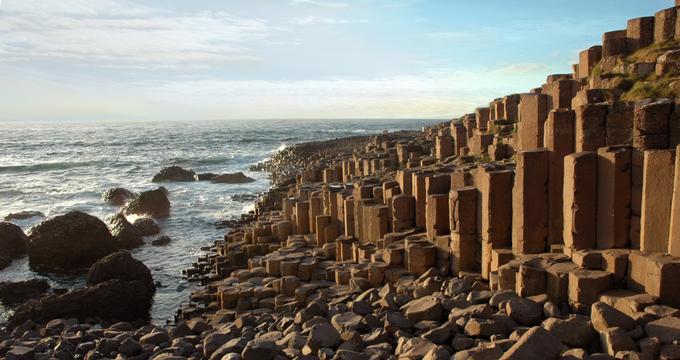Located at the northeast tip of Northern Ireland, Giant’s Causeway is a UNESCO World Heritage Site and one of the most striking natural wonders in the world. Famous for its unique basalt columns, rare wildlife, and cultural legends, this site blends science, history, and myth into one unforgettable destination.
I Find This is Great For:
Nature Lovers: Explore rare plant life, nesting seabirds, and dramatic coastal scenery.
History Buffs: Learn about ancient discoveries, myths, and centuries of human curiosity.
Adventure Walkers: Hike multiple scenic trails, from cliff-top routes to shoreline lookouts.
What to Expect
- Location: County Antrim, Northern Ireland
- World Heritage Status: Designated in 1986
- Geological Formation: Created by ancient volcanic activity during the tertiary epoch
- Visitor Center: Open year-round with interactive exhibits, trails, and guided options
Highlights
- Basalt Columns: Over 40,000 interlocking basalt stones shaped by cooling lava
- Legend of Finn McCool: Interactive exhibits and storytelling bring Irish mythology to life
- Birdwatching: Spot petrels, razorbills, guillemots, and eider ducks
- Rare Flora: Includes hare’s foot trefoil, sea spleenwort, and frog orchids
Outdoor Activities
- Walking Trails: Choose from coastal paths, scenic circuits, and historic routes
- The Organ Trail: View the cliff-face columns and oval-shaped “Giant’s Eyes” formations
- Runkerry Circuit: A cliff-top path with panoramic views of Portrush and Donegal
- Causeway Coast Path: Leads toward Portballintrae, passing rivers, bridges, and beaches
Unique Features
- Natural & Cultural Site: One of only 25 UNESCO sites meeting both criteria
- Volcanic Origins: Proven in 1771 by French geologist Demarest
- Artistic History: Susanna Drury’s 1740 drawings helped make it a Grand Tour stop
- Cultural Wreckage: The Girona shipwreck adds historical intrigue
History & Culture
- Early Discovery: First documented in 1692 by the Bishop of Derry
- Scientific Debate: Sparked 18th-century arguments over natural vs. mythical origin
- Visual Documentation: Detailed sketches commissioned in 1697
- UNESCO Status: Recognized as a World Heritage Site in November 1986
Visitor Tips
- Best Time to Visit: Spring through autumn offers clearer views and better walking conditions
- Audio Tours: Available at the Visitor Center to guide you through history and legends
- Prepare for Weather: Coastal breezes can be brisk—wear windproof layers and sturdy shoes
- Tour Info: The Causeway is included in several Ireland sightseeing tours
Ranger & Educational Programs
- Interactive Exhibits: Discover geological facts and mythical tales inside the Visitor Center
- Local Stories: Hear about the people and legends tied to this ancient place
Conservation & Safety
- Trail Safety: Some paths are narrow or slippery—watch your step and follow signs
- Wildlife Respect: Observe birds and plants from a distance to protect fragile habitats
Contact & Hours
Giant’s Causeway Visitor Centre
Address: Bushmills, County Antrim, BT57 8SU, Northern Ireland
Phone: +44 (0)28 2073 1855
Website: nationaltrust.org.uk
Map
Plan Your Trip


